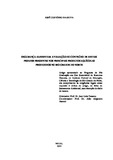Segurança alimentar: avaliação do conteúdo de metais pesados presentes nos principais produtos aquícolas produzidos no Rio Grande do Norte

Visualizar/
Data
2021-08-18Autor
Silva, José Custodio da
http://lattes.cnpq.br/4815704792030543
Metadado
Mostrar registro completoResumo
Heavy metals are a current theme, because depending on their concentrations, these elements can present toxic properties, when in contact with aquaculture organisms they incorporate by bioconcentration or biomagnification these elements can directly affect the human being. This work evaluated the concentrations of heavy metals Fe, Cd, Cu, Pb, Cr, Co, Ni, Ag, Mn and Zn, in light of current standards, the main aquaculture products produced in the state of Rio Grande do Norte, TILAPIA-DO -NILO (Oreochromis niloticus), OYSTER (Crassostrea gazar), SHRIMP (Litopenaeus vannamei), 61 samples from 7 production methods were evaluated, totaling 1530 readings by the atomic absorption method. For the analysis of cobalt, copper, lead, iron, manganese, nickel and silver, the results of all organisms were below the one determined by the legislation. In relation to cadmium, chromium and zinc, some results are in disagreement with the norms. For the results of cadmium, only oyster farms and oysters in the natural environment showed values above those allowed by the Collegiate Board Resolution - RDC No. 42 and by the international standard Food and Agriculture Organization of the United Nations / World Health Organization (FAO/WHO) and European Community (CE), 2005. For chromium samples of tilapia Effluent Treatment Station - ETE, oyster nursery, oyster conventional system, oyster natural environment and shrimp without feed, the results are in discrepancy with the maximum limits established by Ordinance no. No. 685, FAO/WHO. Zinc for oyster conventional system and oyster natural environment showed results above those allowed by Ordinance No. 685. It was concluded that variations in the environment, food and treatment provided for the aquaculture specimens analyzed, including differences between species, environmental conditions, affect accumulation of metals.



